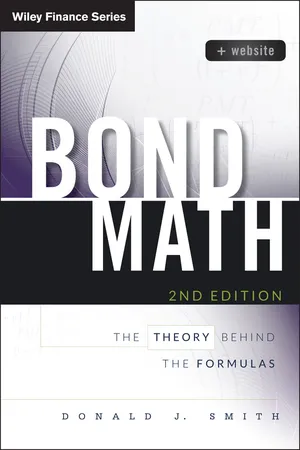
- English
- ePUB (mobile friendly)
- Available on iOS & Android
About this book
A bond calculation quick reference, complete with context and application insights
Bond Math is a quick and easy resource that puts the intricacies of bond calculations into a clear and logical order. This simple, readable guide provides a handy reference, teaching the reader how to think about the essentials of bond math. Much more than just a book of formulas, the emphasis is on how to think about bonds and the associated math, with plenty of examples, anecdotes, and thought-provoking insights that sometimes run counter to conventional wisdom. This updated second edition includes popular Bloomberg pages used in fixed-income analysis, including the Yield and Spread Analysis page, plus a companion website complete with an Online Workbook of multiple choice questions and answers and spreadsheet exercises. Detailed coverage of key calculations, including thorough explanations, provide practical guidance to working bond professionals.
The bond market is the largest and most liquid in the world, encompassing everything from Treasuries and investment grade corporate paper to municipals and junk bonds, trading over $900 billion daily in the U.S. alone. Bond Math is a guide to the inevitable calculations involved in managing bonds, with expert insight on the portfolios and investment strategies that puts the math in perspective. Clear and concise without sacrificing detail, this book helps readers to:
- Delineate the characteristics of different types of debt securities
- Calculate implied forward and spot rates and discount factors
- Work with rates of return, yield statistics, and interest rate swaps
- Understand duration-based risk measures, and more
Memorizing formulas is one thing, but really learning how to mentally approach the math behind bonds is something else entirely. This approach places calculations in context, and enables easier transition from theory to application. For the bond professional seeking a quick math reference, Bond Math provides that and so much more.
Frequently asked questions
- Essential is ideal for learners and professionals who enjoy exploring a wide range of subjects. Access the Essential Library with 800,000+ trusted titles and best-sellers across business, personal growth, and the humanities. Includes unlimited reading time and Standard Read Aloud voice.
- Complete: Perfect for advanced learners and researchers needing full, unrestricted access. Unlock 1.4M+ books across hundreds of subjects, including academic and specialized titles. The Complete Plan also includes advanced features like Premium Read Aloud and Research Assistant.
Please note we cannot support devices running on iOS 13 and Android 7 or earlier. Learn more about using the app.
Information
CHAPTER 1
Money Market Interest Rates
INTEREST RATES IN TEXTBOOK THEORY


Table of contents
- Cover
- Series
- Titlepage
- Copyright
- Dedication
- Preface to the Second Edition
- Preface to the First Edition
- CHAPTER 1 Money Market Interest Rates
- CHAPTER 2 Zero-Coupon Bonds
- CHAPTER 3 Prices and Yields on Coupon Bonds
- CHAPTER 4 Bond Taxation
- CHAPTER 5 Yield Curves
- CHAPTER 6 Duration and Convexity
- CHAPTER 7 Floaters and Linkers
- CHAPTER 8 Interest Rate Swaps
- CHAPTER 9 Bond Portfolios
- CHAPTER 10 Bond Strategies
- Technical Appendix
- Acronyms
- Bibliographic Notes
- About the Author
- Acknowledgments
- About the Companion Website
- Index
- End User License Agreement